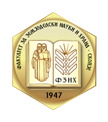STUDY ON INFLUENCE OF SOME CONVENTIONAL AND BIOLOGICAL FERTILIZERS ON THE BIOCHEMICAL COMPOSITION OF FRESH AND DRIED FRUITS OF 'TEGERA' PLUM CULTIVAR
Keywords:
plums, antioxidant activity, total polyphenols.Abstract
The study presents the results of the effect of different fertilization types on the biochemical composition of fresh and dried plum fruit of 'Tegera' cultivar. The scientific experiment was carried out in 2016 at Research Institute of Mountain Stockbreeding and Agriculture - Troyan. Three fertilization types were applied in the experiment: biological, conventional and granulated chicken manure. Higher values for sugars, anthocyanins, tanning substances and pectin were reported as a result of fertilization in comparison with the control. The highest content of total polyphenols in fresh 210.00 mgGAE/100 and dried 390.00 mgGAE/100 fruit was found in the conventional fertilization. The greatest level of antioxidant activity of fresh fruit was found in the variant of chicken manure - 926.67 μmolTE /100 g and the conventional fertilization - 597.78 μmolTE/100 g, while it was 220.00 μmolTE / 100 g in dried fruit variant with the biological fertilization.
References
Arnhold, S., Lindner, S., Lee, B., Martin, E., Kettering, J., Nguyen, T T., Koellner, T. and Sik Ok Huwe, Y. B. (1914). Conventional and organic farming: soil erosion and conservation potential for row crop cultivation. Geoderma 219–220, 89–105.
Burmeister, J., Walter, R. and Fritz, M. (2015). Dungung mit Biogasgarresten –Auswirkungen auf Bodentiere. In: Biogas Forum Bayern Nr. I - 27/2015, Hrsg. ALB Bayerne.V., http://www.biogasforumbayern.de/publikationen/Auswirkung_der_Dungung_mit_Biogasgarres ten_auf_die_Bodentiere.pdf.
Blazˇek, J. (2007). A survey of the genetic resources used in plum breeding. Acta Horticulturae, 734: 31–45.
Cinquanta, L., Di Matteo, M. and Esti, M. (2002). Phisical pre-treatment of plums (Prunus domestica. Part 2. Effect on the quality characteristics of different prune cultivars. Food chemistry, 79: 233-238.
Chauvin, C., Dorel, M., Villenave, C., Roger-Estrade, J., Thuries, L. and Risede, J. M. (2015). Biochemical characteristics of cover crop litter affect the soil food web, organic matter decomposition, and regulation of plant-parasitic nematodes in a banana field soil. Applied Soil Ecology, 96: 131-140.
Chun, O.K., Kim, D.O., Moon, H.Y., Kang, H.G. and Lee, C.Y. (2003). Contribution of Individual Polyphenolics to Total Antioxidant Capacity of Plums. Journal of Agricultural and Food Chemistry, 51: 7240-7245.
Forni, E., Erba, M. L., Maestrelli, A. and Polesello, A. (1992). Sorbitol and free sugar contents in plums. Food Chem., 44: 269-275.
Cuquel, F.L., Motta, A. C. V., Tutida, I. and May de Mio, L. L. (2011). Nitrogen and potassium fertilization affecting the plum postharvest quality, Rev. Bras. Frutic., Jaboticabal - SP, Especial, E., Outubro: 328-336.
Reganold, J., Elliott, L. and Unger, Y. (1987). Long-term effects of organic and conventional farming on soil erosion. Nature., 330: 370-372
Ruiz, R. (2006). Effects of different potassium fertilizers on yield, fruit quality and nutritional status of ‘Fairlane’ nectarine trees and on soil fertility. Acta Horticulturae, The Hague, 721: 185190.
Kader, A. A. and Rolle, R.S. (2004) .The role of post-harvest management in assuring the quality and safety of horticultural produce. FAO Bulletin, Washington, 152: 52.
Kaulmann, A., Jonville, M. C., Schneider, Y. J, Hoffmann, L. and Bohn, T. (2014). Carotenoids, polyphenols and micronutrient profiles of Brassica oleraceae and plum varieties and their contribution to measures of total antioxidant capacity., Food Chemistry 155 Oxford: Elsevier Ltd: 240-250.
Kim, D.O., Chun, O.K., Kim, Y.J., Moon, H.Y. and Lee, C.Y. (2003). Quantification of Polyphenolics and Their Antioxidant Capacity in Fresh Plums. Journal of Agricultural and Food Chemistry, 51: 6509-6515.
Miloševid, T. and Miloševid, N. (2012). Main physical and chemical traits of fresh fruits of promising plum hybrids (Prunus domestica L.) from Cacak (Western Serbia), Romanian Biotechnological Letters, 17(3): 7358-7365.
Stancheva, Y. (2007). Analysis of factors inducing instability in agricultural production in Bulgaria, http://chm.moew.government.bg/SLM/files/1- Sust_agr.pdf
Stoykova, G. (2004). Organic agriculture in Bulgaria - origin, characteristics and advantages; – Scientific and Practical Conference with International Participation (Reports – vol. 2); Svishtov, 11-13.11.2004.
Thoden, T. C., Korthals, G. W. and Termorshuizen, A. J. (2011). Organic amendments and their influences on plant-parasitic and free-living nematodes: a promising method for nematode management. Nematology, 13(2): 133-153.
Vitanova, I. M. (1990). Determination of needs for fertil¬izer of plum trees. Acta Horticulturae, The Hague, 274: 501-508.
Walkowiak-Tomczak, D., Reguіa, J. and Јysiak, G. (2008). Physico-chemical properties and antioxidant activity of selected plum cultivars fruit, Acta Sci. Pol., Technol. Aliment, 7(4): 15-22
Yadav, R. L., Dwivedi, B. S. and Pandey, P. S. (2000). Rice–wheat cropping system: assessment of sustainability under green manuring and chemical fertilizer inputs, Field Crop Res. 65: 15–30.



